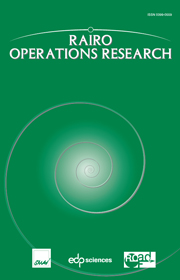Crossref Citations
This article has been cited by the following publications. This list is generated based on data provided by
Crossref.
Ghosh, Tamal
Doloi, B
and
Dan, Pranab K
2017.
Utilization-based grouping efficiency and multi-criteria decision approach in designing of manufacturing cells.
Proceedings of the Institution of Mechanical Engineers, Part B: Journal of Engineering Manufacture,
Vol. 231,
Issue. 3,
p.
505.
Maganha, Isabela
and
Silva, Cristóvão
2017.
A Theoretical Background for the Reconfigurable Layout Problem.
Procedia Manufacturing,
Vol. 11,
Issue. ,
p.
2025.
Bortolini, Marco
Galizia, Francesco Gabriele
and
Mora, Cristina
2018.
Reconfigurable manufacturing systems: Literature review and research trend.
Journal of Manufacturing Systems,
Vol. 49,
Issue. ,
p.
93.
Maganha, Isabela
Silva, Cristovao
and
Ferreira, Luis Miguel D. F.
2019.
The layout design in reconfigurable manufacturing systems: a literature review.
The International Journal of Advanced Manufacturing Technology,
Vol. 105,
Issue. 1-4,
p.
683.
Brahimi, Nadjib
Dolgui, Alexandre
Gurevsky, Evgeny
and
Yelles-Chaouche, Abdelkrim R.
2019.
A literature review of optimization problems for reconfigurable manufacturing systems.
IFAC-PapersOnLine,
Vol. 52,
Issue. 13,
p.
433.
Bortolini, Marco
Galizia, Francesco Gabriele
and
Mora, Cristina
2019.
Dynamic design and management of reconfigurable manufacturing systems.
Procedia Manufacturing,
Vol. 33,
Issue. ,
p.
67.
Maganha, Isabela
Silva, Cristovao
Klement, Nathalie
dit Eynaud, Amélie Beauville
Durville, Laurent
and
Moniz, Samuel
2019.
Hybrid optimisation approach for sequencing and assignment decision-making in reconfigurable assembly lines.
IFAC-PapersOnLine,
Vol. 52,
Issue. 13,
p.
1367.
Bortolini, M.
Botti, L.
Galizia, F. G.
and
Mora, C.
2020.
Reconfigurable Manufacturing Systems: From Design to Implementation.
p.
123.
Behnia, Bardia
Shirazi, Babak
Mahdavi, Iraj
and
Paydar, Mohammad Mahdi
2021.
Nested Bi-level metaheuristic algorithms for cellular manufacturing systems considering workers’ interest.
RAIRO - Operations Research,
Vol. 55,
Issue. ,
p.
S167.
Sotudian, Shahabeddin
Sadat Asl, Ali Akbar
and
Fazel Zarandi, Mohammad Hossein
2021.
Fuzzy Gilmore and Gomory algorithm: Application in robotic flow shops with the effects of job-dependent transportation and set-ups.
RAIRO - Operations Research,
Vol. 55,
Issue. ,
p.
S1515.
Yelles-Chaouche, Abdelkrim R.
Gurevsky, Evgeny
Brahimi, Nadjib
and
Dolgui, Alexandre
2021.
Reconfigurable manufacturing systems from an optimisation perspective: a focused review of literature.
International Journal of Production Research,
Vol. 59,
Issue. 21,
p.
6400.
Feng, Yongbing
Gao, Guohua
Wang, Pengyu
Zhang, Zihua
and
Liu, Kai
2025.
Introducing reconfigurable manufacturing systems to agriculture.
Flexible Services and Manufacturing Journal,
Vol. 37,
Issue. 3,
p.
816.

